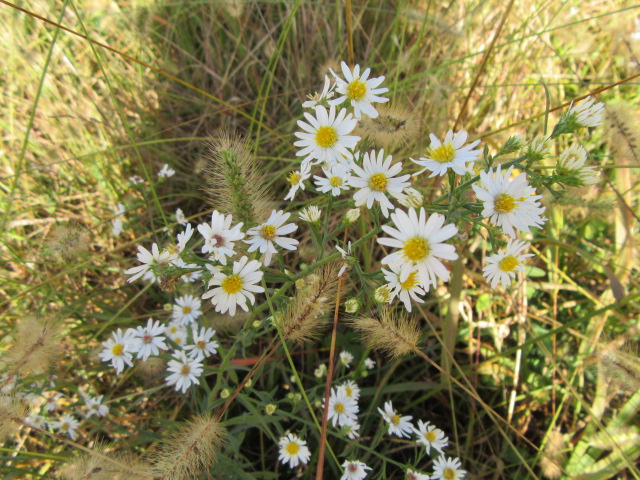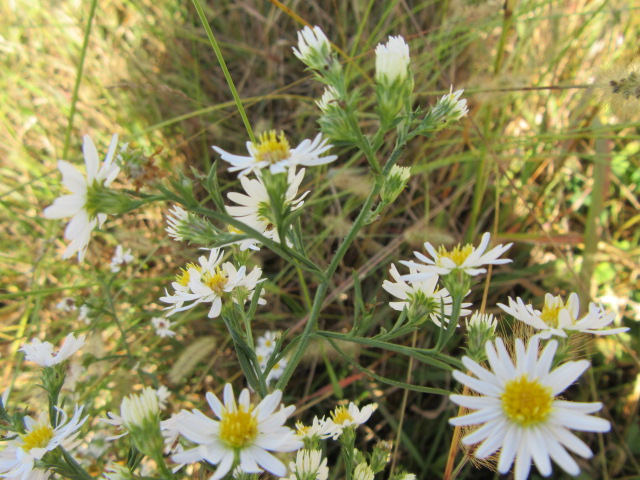
Symphyotrichum lanceolatum (Tall White Aster) on 10-9-22, #916-8.
Tall White Aster, Eastern Line Aster, Lance-Leaved American Aster, Panicled Aster, White Panicled Aster, Wild Aster
Symphyotrichum lanceolatum
sim-fy-oh-TRY-kum lan-see-oh-LAY-tum
Symphyotrichum lanceolatum (Willd.) G.L.Nesom is the accepted scientific name for this species of Aster. It was named and described as such by Guy L. Nesom in Phytologia in 1995. It was first named and described as Aster lanceolatus by Carl Ludwig Willdenow in the fourth edition of Species Plantarum in 1803.
Accepted Infraspecific Names (5) (Updated on 12-4-23 from POWO): Symphyotrichum lanceolatum var. hesperium (A.Gray) G.L.Nesom, Symphyotrichum lanceolatum var. hirsuticaule (Semple & Chmiel.) G.L.Nesom, Symphyotrichum lanceolatum var. interior (Wiegand) G.L.Nesom, *Symphyotrichum lanceolatum subsp. lanceolatum (autonym), Symphyotrichum lanceolatum var. latifolium (Semple & Chmiel.) G.L.Nesom. *When infraspecific taxon are named, an autonym (“type-specimen”) is automatically generated whose description is closest to the (original) species. All have their own list of synonyms…
POWO lists 5 lower taxa of Symphyotrichum lanceolatum, Missouri Plants says Steyermark’s Flora of Missouri lists 3 in this state (several years ago), the USDA Plants Database has only 2, and World Flora Online lists 11 (but their list is weird), Tropicos Flora of Missouri lists 5 in the state, but only S. lanceolatum var. interior and S. lanceolatum var. lanceolatum are the two likely found around where I live. There were more, but they are either synonyms or are now considered separate species.
The genus, Symphyotrichum Nees., was named and described by Christian Gottfried Daniel Nees von Esenbeck in Genera et Species Asterearum in 1832.
As of 12-4-23 when this page was last updated, Plants of the World Online by Kew lists 100 species in the Symphyotrichum genus. It is a member of the plant family Asteraceae with 1,702 genera. Those numbers could change as updates are made on POWO.

Distribution map of Symphyotrichum lanceolatum from Plants of the World Online. Facilitated by the Royal Botanic Gardens, Kew. Published on the Internet; http://www.plantsoftheworldonline.org/. Retrieved on October 18, 2022.
The above distribution map for Symphyotrichum lanceolatum (including all lower taxon) is from Plants of the World Online. Areas in green are where the species is native and purple is where it has been introduced. The map on the USDA Plants Database for The United States and Canada is the same.
The map on iNaturalist shows where members have made observations. Anyone can join and it is a great website to confirm and share your observations. The maps on iNaturalist are continually updated as members post new observations.
THERE ARE SEVERAL LINKS AT THE BOTTOM OF THE PAGE FOR FURTHER READING AND TO HELP WITH A POSITIVE ID.

Symphyotrichum lanceolatum (Tall White Aster) on 10-9-22, #916-9.
There are several Symphyotrichum species on my farm with white flowers that have been tricky to identify. In fact, for several years I just kind of ignored them and worked on much easier species. I was working on a couple of species in the back of the farm that I found in 2021. Walking through the main hayfield where Erigeron annuus is the prevalent species late in the summer, I noticed a few plants whose flowers were different. One of the main keys for identifying white-flowered Symphyotrichum species is the number of ray florets (petals) and involucral bracts on the underside of the flowers… Of course, their leaves also play an important part. Similar species, such as S. lateriflorum (Calico Aster) and S. ontarionis (Ontario Aster) prefer a shadier location. S. lateriflorum also has much smaller flowers. Those two species are behind the pond in the back of the farm.
Personally, I think all daisy-type species with small white flowers are very difficult to identify with clarity. Synphyotrichum species are the worse for me! Normally, when I put photos of my observations on iNaturalist, members will agree or suggest and ID. They pass by Symphyotrichum species like the plague! I have to message or tag a few members who are experts in the genus…

Symphyotrichum lanceolatum (Tall White Aster) on 10-9-22, #916-10.
When I saw the plants in the pasture, the first thing I did was look at the involucral bracts to make sure it was a Symphyotrichum species. The second thing was to count the ray petals (or florets). I took close-ups but they didn’t turn out so well. Typically, S. lanceolatum has flower heads that are 1/2-1″ in diameter, and have 16 to 50 ray florets in 1 or 2 series (you can see this where they overlap). Different websites give different numbers, and they are usually white but can be bluish to violet. The disc florets in the center number from 15-40, are brighter yellow, turning a reddish-pink with age. The involucre is cup-shaped to bell-shaped. The bracts (phyllaries) are in 3-5 (6) unequal, overlapping series. They are appressed to slightly spreading…

Symphyotrichum lanceolatum (Tall White Aster) on 10-12-22, #918-3.
Symphyotrichum lanceolatum can grow up to about 60″ (1.5 m) tall. They branch out above the midpoint. The stems are sparsely pubescent (hairy) usually in longitudinal lines above the midpoint and hairless below. The leaves, up to about 3 1/2″ to 5″ long, are said to be oblanceolate to narrowly lanceolate… The margins of mid to lower leaves are slightly toothed or scalloped. They are glabrous (smooth) with a few hairs around the margins.

Symphyotrichum lanceolatum (Tall White Aster) on 10-12-22, #918-4.
The plants produce quite a number of flowers in panicles that arise from the upper leaf nodes. Some species, such as S. lateriflorum, produce flowers on one side of the stems, but this species doesn’t normally do that unless the stems are lying down.
Symphyotrichum lanceolatum mainly prefers full sun whereas similar species may prefer a shadier location.
I hoped to take better photos in 2023 but we had the worst drought I can remember. This species may have come up early in the summer, but there were none to be found by the time they would have produced flowers. It was so hot and dry that most of the wildflowers were burned up by mid-July…
You can upload photos on iNaturalist and submit an observation and hope another member will agree or add another suggestion. Rarely will anyone respond since Symphyotrichum species are controversial… When you upload, iNaturalist will list suggestions that may not always be accurate, which is understandable. Next to the suggestion, you will see the word “view”. Click on that… Then to the right of the page that pops up, you will see top identifiers, etc. You can contact one of them, send a link to your observation, and have them take a link. Some of them are curators and botanists and they will take a look and tell you what they think. Take many photos, as close up as you can…
OH, one other thing you can do to compare species, is to go to Flora of North America Species Comparison page. You can compare up to four different species.
I hope you found this page useful and be sure to check the links below for more information. They were written by experts and provide much more information. Some sites may not be up-to-date but they are always a work in progress. If you can, I would appreciate it if you would click on the “Like” below and leave a comment. It helps us bloggers stay motivated. You can also send an email to me at thebelmontrooster@yahoo.com. I would enjoy hearing from you especially if you notice something is a bit whacky.
FOR FURTHER READING:
PLANTS OF THE WORLD ONLINE (GENUS/SPECIES)
INTERNATIONAL PLANT NAMES INDEX (GENUS/SPECIES)
TROPICOS (GENUS/SPECIES)
FLORA OF MISSOURI (GENUS/SPECIES)
FLORA OF NORTH AMERICA (GENUS/SPECIES)
WORLD FLORA ONLINE (GENUS/SPECIES)
WIKIPEDIA (GENUS/SPECIES)
USDA PLANTS DATABASE
iNATURALIST
MISSOURI PLANTS
WILDFLOWER SEARCH
DAVE’S GARDEN
FLORA FINDER
FLORA OF PENNSYLVANIA
FRIENDS OF THE WILDFLOWER GARDEN
GO BOTANY
ILLINOIS WILDFLOWERS
JUNGLE DRAGON
KANSAS WILDFLOWERS AND GRASSES
MARYLAND BIODIVERSITY PROJECT
MICHIGAN FLORA
MINNESOTA WILDFLOWERS
NOTE: The data (figures, maps, accepted names, etc.) may not match on these websites. It depends on when and how they make updates and when their sources make updates. Some websites have hundreds and even many thousands of species to keep up with. Accepted scientific names change periodically and it can be hard to keep with as well. Some of the links may use a name that is a synonym on other sites. In my opinion, Plants of the World Online by Kew is one of the most reliable and up-to-date plant databases and they make updates regularly. I make updates “at least” once a year and when I write new pages or add new photos but I do get behind. We are all a work in progress. 🙂